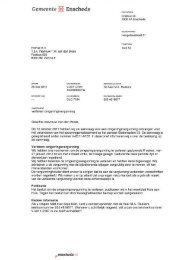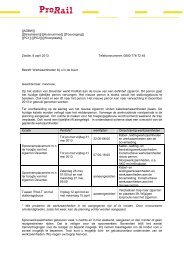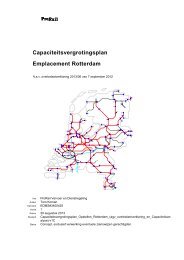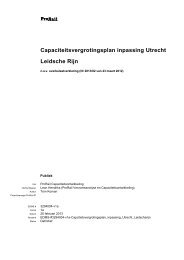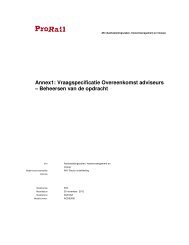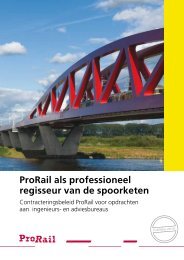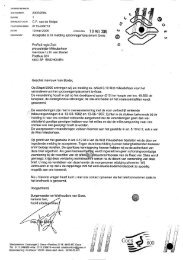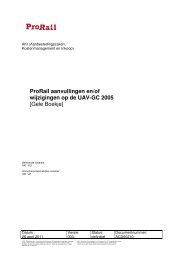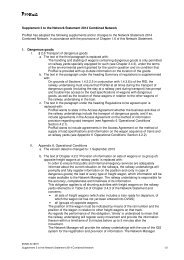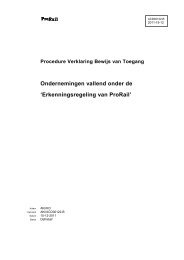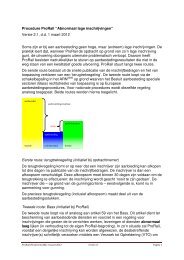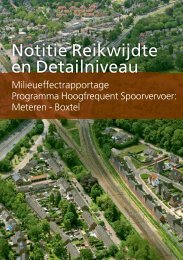Network Statement 2014 - ProRail
Network Statement 2014 - ProRail
Network Statement 2014 - ProRail
- No tags were found...
You also want an ePaper? Increase the reach of your titles
YUMPU automatically turns print PDFs into web optimized ePapers that Google loves.
Exceptional Transport, subject to the applicable conditions laid down by <strong>ProRail</strong>. Also, the vehicleload may not exceed the maximum permissible load specified for that vehicle.3.3.2.3 Line gradients• The gradient of stabling lines shall not exceed 1:1000.• The gradient of other tracks shall as a rule not exceed 1:200. In case of larger gradients, thesignalling shall be equipped to ensure that heavy trains need not be brought to a stop on suchgradients.3.3.2.4 line speeds• The permissible line speed is the highest speed allowed on a route section or a part thereof. Thespeed class of the permissible line speed is indicated per route section in appendix 16.3.3.2.5 Maximum train lengths• The maximum train length (including locomotive) is 400m (excluding a tolerance of 1% accordingto the TSI ‘Rolling Stock’ of the trans-European high-speed rail system) for high-speed passengertrains and 750m for freight trains.• Trains in excess of these maximum train lengths may only run as Exceptional Transport, subjectto conditions laid down by <strong>ProRail</strong> (additional service).• Passenger trains may not exceed the effective length of the platform tracks that they are to useaccording to the timetable. A list of effective platform lengths per route section and for the mostimportant stations is included as appendix 19.• The length of freight trains must be attuned to the range of use that applies to the route section onwhich the train is scheduled according to the timetable. In case of a detour, the range of use forthe detour route is determinative.3.3.2.6 Power supplyThe railways managed by <strong>ProRail</strong> include facilities for diesel traction and for electrical traction via theoverhead contact line.• Refuelling systems are available for diesel traction users; see Chapter 3.8.4.• The route sections fitted out with an overhead line for electrical traction are shown in appendix 17.• The contact line voltage and maximum current collection per route section are shown in appendix17. Contact line voltage and current collection are in accordance with EN 50367.• The height of the overhead contact line in relation to the top edge of the rail is +5.50 m asstandard on route sections with profile ‘GC’ or ’NL’ (see appendix 12). A different height may applyat the location of structural works, although the overhead contact line remains beyond thereference profile locally applicable.• The provisions at transition points to other contact line voltages are shown in appendix 17.• De-icing of the overhead contact line can under certain conditions be applied on route sectionsfitted with a de-icing circuit.Regulations to be agreed upon:► The contractual conditions for use of the overhead contact line are agreed upon in the AccessAgreement for the Overhead Contact Line service.<strong>ProRail</strong> requires the railway undertaking to provide particulars per type of electric railway vehicleas described in Section 3 of appendix 8. ◄3.3.2.7 Information available on request• Angle ratios of points with permitted speeds.• Locally applicable speed limits.• Permissible speeds per route.• Effective platform length per station, per platform track and per direction of traffic.• Effective length of stabling lines and tracks.• Contact line voltage tolerances<strong>Network</strong> <strong>Statement</strong> <strong>2014</strong> Combined <strong>Network</strong> - version 1.0 dated 9 January 2013 page 25



